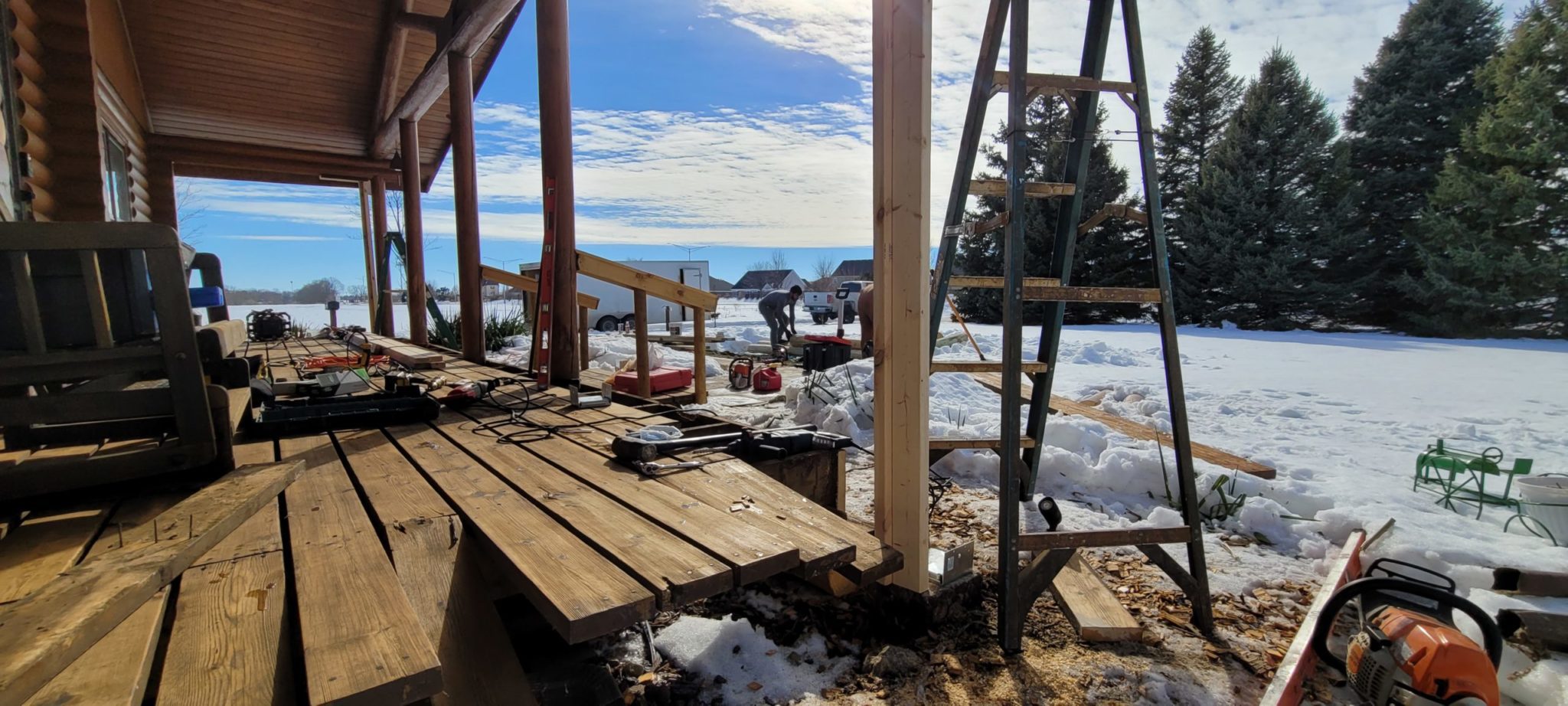
Most experienced log homeowners have a basic understanding of what log home maintenance entails. However, many do not realize all of the factors that go into a log home restoration estimate. When we quote a restoration or maintenance job, we must not only walk through our log home maintenance checklist to determine what work is necessary but also consider travel and equipment requirements, the style of log home we are working on, and the home’s maintenance history. If you have questions about all of the factors we consider in a log home estimate, you’re in luck because we have all the answers! By the time you read this post, you will also have this Log Master knowledge at your disposal. Basic Information Needed to Start Your Restoration Estimate When homeowners call our toll-free number, we will ask for the basic information most service providers need to begin a project. This includes: First and last name Phone number and email address The physical address of the cabin The square footage of your log home What prompted you to call? It seems normal, but some prefer to keep out their phone number or physical location out of fear. Rest assured, we do not share information collected or sell our client list. We hate it when companies do it to us, so to avoid hypocrisy and show respect for our clients, we refuse to participate in selling our client list. Whatever you share stays in-house for in-house use only. After we collect this basic information, we will ask you to send us photographs of your log home. Log Home Photos: A Necessity for Online Estimates They say a picture is worth a thousand words, and this could not be truer when providing a log home restoration estimate. These images give us an idea of the log home’s condition and help us determine the cabin’s floor plan, the land surrounding the home, and any obstacles we may need to work around. In many cases, it’s easier for us (and for you) if we can see the log home. This is because it’s hard to verbalize certain types of damage or areas of concern. List of Suggested Pictures This list of suggested log home photographs ensures your log home’s needs are effectively communicated. Please keep in mind this list is not exhaustive, and we may request additional photos for more context. To start, we suggest you take pictures of the following environmental obstacles: A house over a lake or water Road access problems Power lines that are attached to the log cabin Your windows and door frames (common areas for log rot or insect damage) Facia and nearby logs Logs near the ground (especially if the log height is less than one foot above the ground) Areas of regular shade (you will often see a green hue on these logs) West and south-facing walls (they get the most rain) East and north-facing walls (especially if your location makes it difficult for them to dry out) Decks (if you want it included in your estimate) Posts or columns on the front or back porches Any cracks, bubbling, or weathered chinking and finishing Extended horizontal checks (cracks) in the logs that may hold rain (typically on the top of a log) Signs of insects Other areas that would benefit from an expert eye Guidelines for Precise Pictures You can use a phone or camera to photograph the items mentioned above. The device does not matter; it’s the precision we care about in order to make an accurate repair or restoration estimate. This avoids inaccurate estimates or change orders once we arrive and begin the work. For areas of concern that include cracks, log rot, or other blemishes, we recommend using a ruler, tape measure, quarter, or soda to provide perspective within the images. Also, it helps if you can take multiple shots from different angles of potential log rot, insect damage, caulk or chink separation, and cracked or missing finishes. If you need clarification, please call us so we can assist you. Primary Factors Impacting Your Restoration Estimate One of the best things about log homes is most of them are unique. However, this means that we can’t provide cookie-cutter restoration estimates. We must evaluate each home with fresh eyes and assess what is needed. With your photos, we can accurately assess your log home’s needs. We may recommend the products and services listed below based on what we see. We love sharing our expertise to educate our clients on how the types of logs, caulk or chink, log rot or insect damage, and issues with clear finishes impact our log home repair estimate. 1. Type of Log Home Exterior What makes a log home a log home? The exterior and interior? Is it based on appearance or structural makeup? Depending upon who you ask, opinions on what qualifies as a log home vary. Big or small, there are two types of cabins: log-sided and log-built. Log Sided Homes Log-sided homes can look just as beautiful as a log cabin. This “log home look” is budget-conscious but requires regular maintenance, just like any other log home. We can replace pieces with log-sided homes if they are rotted without impacting the structural integrity. However, we must also take certain precautions to avoid damage to interior walls. Additionally, log-sided homes are still log homes, meaning they must be regularly stained. Stain protects the wood from water and other elements while preserving its natural beauty. We may ask additional questions about the type of log siding used on your home to provide the most accurate restoration estimate. Log-Built Homes There are a variety of styles for log-built homes, both in terms of log style and log species. These homes can be made from a variety of trees, including fir, cedar, pine, oak, and cypress. Furthermore, log homes can be built in different ways, such as full scribe, post and beam, timber frame, and more. These decisions are often made based on personal preferences and functionality, but they are also variables that can impact the cost of log home restorations and repairs. 2. Log Styles It’s also important for us to know the type (or types) of log style used to construct your cabin. Knowing your type of log style is generally easy to tell from pictures. However, your home may have multiple kinds of logs or styles of logs and log siding or a combination. It is not unheard of to discover part of the cabin was made with Douglas fir logs in a specific style and an addition to the home done in cedar logs of a different style and log siding around the foundation. Log styles can go a step further when considering the exterior log surface, joints, corners, and ends. Each of these also contributes to factors drastically impacting the time needed to fix log rot in a given area. Some log rot is only a foot or two in length. To save money, rather than order a complete log in that style, a skilled log master may cut/mill another log on the site. 3. Chink and Caulk Log homes typically use caulk or chink between the logs as a barrier from the elements and to protect the logs from water damage. The main difference between the two is elasticity and texture. Chink is more commonly used for large gaps between logs and is sometimes two inches wide, while caulk is used for smaller or tight gaps. Mortar vs. Synthetic Chink Two types of chinking are typically used in log homes: mortar and synthetic. Each has its pros and cons, and both can impact your log home repair estimate. Mortar chinking is a concrete-like substance that is generally cheaper and around 10% of the price of synthetic chinking. However, mortar can crack and break down as the house settles, allowing moisture between the logs. Also, mortar chinking can be more challenging to remove, especially if trapped moisture causes log rot. Nowadays, chink is made from synthetic material to allow for more elasticity to combat the seasons when the logs shrink and expand. Although the initial cost can be more expensive, it is far more durable and likely to prevent costly repairs in the future. Caulking Caulk is almost always used around windows and doors or small tight joints on log homes. It has a higher elasticity than chink but often lacks textures. Likewise, it comes in a few colors to match the stain, chink, making it nearly invisible to the naked eye. It is also much easier to apply than chinking, meaning less time spent restoring your home. Less time often equals lower costs. 4. Log Rot and Insects Customers often call us for restoration estimates because they have noticed areas of concern on the exterior of their homes. Both log rot and insect infestation can cause extreme damage and represent the bulk of the estimated costs. Log rot is at the top of most log cabin homeowners’ concerns. You may have noticed black behind the finish or chunky pieces falling away. These could be signs of log rot or a poor finish. Often, log rot occurs due to the homeowner’s inability to keep up with regular maintenance or their inability to heed the recommended care instructions of the log home builder. Unfortunately, since most types of log rot require us to replace the affected logs, it is a major consideration for log home restoration estimates. Insect damage comes in as a close second for homeowner concerns, as most types of insect infestations are highly visible. Although insect damage doesn’t always require us to completely replace logs, it does involve a series of removal and repair steps before we can re-stain the logs. 5. Damage From Previous Restoration Projects Given current prices for home construction materials, we know it is tempting to hire a friend or self-employed individual with construction experience to repair your log home. Construction or carpentry experience is a background we look for when hiring Log Master’s Apprentices, but it is not the only experience needed to restore log cabins. Carpentry is a great skill set with a lot of value. Any good carpenter could probably learn how to restore a log cabin with time and education. However, resto...
Via https://logmastersrestorations.com/blog/what-are-the-considerations-for-log-home-restoration-estimates/
source https://johnkbrown90.weebly.com/blog/what-are-the-considerations-for-log-home-restoration-estimates

